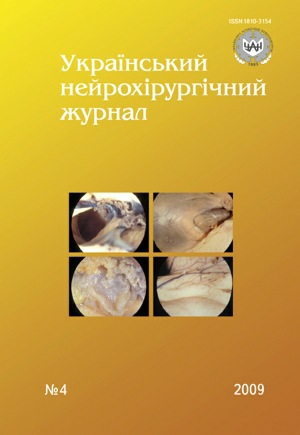Cranial nerves hyperactive dysfunction syndromes in combination with extracerebral tumors of posterior fossa
DOI:
https://doi.org/10.25305/unj.108007Keywords:
extracerebral tumor of posterior fossa, trigeminal neuralgia, hemifacial spasm vascular compressionAbstract
22 cases of hyperactive dysfunction syndromes (HDS) of cranial nerves (20 — trigeminal neuralgia, 2 — hemifacial spasm) in combination with extracerebral tumors in posterior fossa (9 — meningioma, 6 — acoustic nerve tumor, 6 — cholesteatoma, 1 — angiolipoma) were observed. Clinical investigation, MRI and intraoperative microtopography of nerves, vessels and tumors relationships were conducted.
A conclusion was made that single tumor compression of cranial nerve is not enough for HDS development. HDS of cranial nerves in case of tumor in posterior fossa develops when vascular compression exists.
References
Федірко В.О., Чувашова О.Ю. Діагностика судинної компресії черепних нервів з використанням магніторезонансної томографії. Кореляція з клініко-операційними даними // Укр. нейрохірург. журн. — 2004. —№2. — С.94–101.
Barrow D.L., Barrow J. Surgery of the cranial nerves of the posterior fossa. — Thieme, 1993. — 322 p.
Bullitt E., Tew J.M., Boyd J. Intracranial tumors in patients with facial pain // J. Neurosurg. — 1986. — V.64. — P.865–871.
Chang J.W., Choi J.Y., Yoon Y.S. et al. Unusual causes of trigeminal neuralgia treated by gamma knife radiosurgery // J. Neurosurg. — 2002. — V.97, suppl.5. — P.533–535.
Dandy W.E. Concerning the cause of trigeminal neuralgia // Am. J. Surg. — 1934. — N24. — P.447–455.
Grigoryan Yu.A., Onopchenko C.V. Persistent trigeminal neuralgia after removal of contralateral posterior cranial fossa tumor. Report of two cases // Surg. Neurol. — 1999. — V.52. — P.56–61.
Huynh-Le P., Matsushima T., Hisada K., Matsumoto K. Glossopharyngeal neuralgia due to an epidermoid tumor in the cerebellopontine angle // J. Clin. Neurosci. — 2004. — V.11, N7. — P.758–760.
Kakizawa Y., Hongo K., Takasawa H. et al. “Real” three-dimensional constructive interference in steady-state imaging to discern microsurgical anatomy // J. Neurosurg. — 2003. — V.98. — P.625–630.
Kakizawa Y., Seguchi T., Kodama K. et al. Anatomical study of the trigeminal and facial cranial nerves with the aid of 3.0-tesla magnetic resonance imaging // J. Neurosurg. — 2008. — V.108. — P.483–490.
Kobata H., Kondo A., Iwasaki K., Nishioka T. Combined hyperactive dysfunction syndrome of the cranial nerves: trigeminal neuralgia, hemifacial spasm, and glossopharyngeal neuralgia: 11-year experience and review // Neurosurgery. — 1998. — V.43, N6. — P.1351–1362.
Kumon Y., Sakaki S. Kohno K. et al. Three-dimensional imaging for presentation of the causative vessels in patients with hemifacial spasm and trigeminal neuralgia // Surg. Neurol. — 1997. — V.47. — P.178–184.
Kumon Y., Sakaki S., Ohue S. et al. Usefulness of heavily T2-weighted magnetic resonance imaging in patients with cerebellopontine angle tumors // Neurosurgery. — 1998. — V.43, N6. — P.1338–1343.
McLaughlin M.R., Jannetta P.J.,ClydeB.L. et. al. Microvascular decompression of cranial nerves: lessons learned after 4400 operations // J. Neurosurg. — 1999. — V.90. — P.1–8.
Regis J., Metellus P., Dufour H. et al. Long-term outcome after gamma knife surgery for secondary trigeminal neuralgia // J. Neurosurg. — 2001. — V.95. — P.199–205.
Wilkins R.H. Neurovascular decompression procedures in the surgical management of disorders of cranial nerves V, VII, IX, and X to treat pain. Functional Neurosurgery // Neurosurgery / Eds. R.H. Wilkins, S.S. Rengachary. — N.Y.: McGraw-Hill, 1996. — P.1457–1467.
Downloads
Published
How to Cite
Issue
Section
License
Copyright (c) 2009 V. O. Fedirko

This work is licensed under a Creative Commons Attribution 4.0 International License.
Ukrainian Neurosurgical Journal abides by the CREATIVE COMMONS copyright rights and permissions for open access journals.
Authors, who are published in this Journal, agree to the following conditions:
1. The authors reserve the right to authorship of the work and pass the first publication right of this work to the Journal under the terms of Creative Commons Attribution License, which allows others to freely distribute the published research with the obligatory reference to the authors of the original work and the first publication of the work in this Journal.
2. The authors have the right to conclude separate supplement agreements that relate to non-exclusive work distribution in the form of which it has been published by the Journal (for example, to upload the work to the online storage of the Journal or publish it as part of a monograph), provided that the reference to the first publication of the work in this Journal is included.









